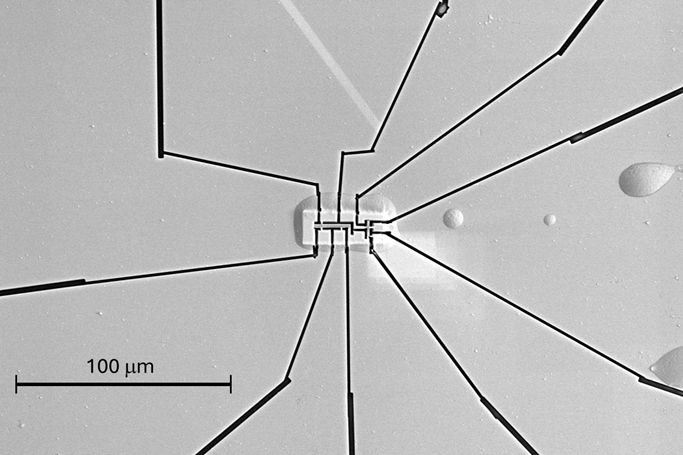Bell group
Research Interests & Activities
My research focuses on the creation and control of novel electronic phases of quantum matter in metals, semiconductors, and insulators. Recently my work has centred on actinide-based thin films, focussed ion beam nanofabrication of 1D, 2D and 3D quantum materials, including superconductors and magnetic materials. Understanding how these two types of long-range order, which usually do not exist together in nature, combine and interact is another key area of interest.
I also use field-effect gating geometries, precise thin film heterostructures, proximity effects and photoconductivity to induce and continuously tune the electronic properties of these systems. Since the materials science and chemistry of these materials is vital to control and understand in these systems, the research spans a broad range of disciplines. The samples are typically characterized at low temperatures and high magnetic fields, and hence the studies fundamental in nature. These underlying aims feed into the global community’s aspirations of creating new functional materials and devices for future applications.
Advanced Nanofabrication for Quantum Material Exploration
In this work, we seek to develop such capability through the creation of a new experimental platform that exploits the power and versatility of Focused Ion Beam microscopes (FIBs). The FIB is an advanced nanofabrication tool that bypasses the limitations of other lithography techniques, since it directly images and etches material without a mask or template, and is therefore capable of sculpting small and irregular crystals into a desired architecture. FIBs can achieve spot sizes with resolution approaching 10 nm, as well as deposit material on the sub-micron scale. Using this tool we can restrict charge and heat current to flow along specific crystallographic directions, as well as modify the size and geometry of the samples. Nanoscale defects can also be isolated for specific study.

Historically, FIBs have primarily used a Ga source for the ion beam, which can give problems with Ga contamination. Recently, a new generation of Plasma FIBs (PFIBs) has been developed that have revolutionised the capabilities and versatility of this technique – we have one such system in Bristol. Remarkably, up to 60 times more material can be removed by a PFIB compared to a traditional Ga FIB in an equivalent time, allowing larger areas to be etched. The image shows an FIB etched FeSe device (centre) with Au wiring (courtesy of M. Aldis).
Fundamental physics and materials science of actinide thin films
Bristol hosts a range of thin film sputtering systems, FaRMS, unique in the UK, capable of creating high quality thin films of actinide materials (U and Th: compounds, alloys and heterostructures). This opens up a wide range of fascinating directions broadly in the area of creating and controlling novel types of superconducting thin films and devices using actinide materials, from fundamental materials science and physics, to device fabrication. A recent review of the general area of thin films of uranium is here. An example of the research is the fundamental physics of elemental uranium metal, which shows charge-density wave transitions and superconductivity – both of which we can tune with epitaxial strain, and substrate templating that can even control the crystal symmetry. Recently we could stabilise the hexagonal close-packed (hcp) phase of U metal, which does not exist in nature, by using thin film buffers of Ir and Cu. However these samples were not stable over time and coherently transformed into the more standard orthorhombic form of U over several days: the image shows X-ray diffraction data of the drop in intensity (red arrow) of U-hcp peaks concomitant with growth in intensity of the U-orthorhombic peak (black arrow), showing a coherent/topotactic transition from one structure to another [adapted from Nicholls et al., Phys. Rev. Mater. 6, 103407 (2022)]. This result was unexpected, and emphasises the highly complex and fascinating materials physics of U.

Current researchers and PhD students
Dr. Tom Robinson
Senior Research Associate
PhD Students
- Miriam Aldis
- Syed Hussain
